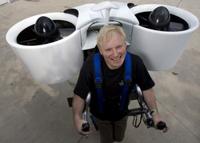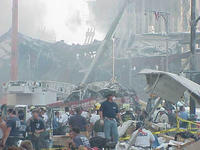-
Wireless underground robots for first responders
First responders may have to look for victims in hostile or challenging environments, such as clandestine tunnels, subway systems, and underground structures; sending a wireless robot to look around and pull victims out would be safer
-
-
Fort Wayne Mayor dissolves joint homeland security department
After six years of operation, the joint Fort Wayne-Allen County Homeland Security Department has been dissolved; last week Tom Henry, the Mayor of Fort Wayne, Indiana sent a letter to county officials notifying them of the city’s plans to end its agreement to share in the costs of the local homeland security department
-
-
Running robots for hard-to-reach places
A large fraction of the Earth’s surface remains inaccessible to conventional wheeled or tracked vehicles, while animals and humans traverse such terrain with ease and elegance; scientists are working to develop search-and-rescue robots which emulate animal or human walking, thus making them more capable of saving people in hard-to-reach places
-
-
First responders could be zipping through skies within two years

Glenn Martin, the inventor of the Martin Jetpack, the world’s first commercially available jetpack, recently spoke with Homeland Security NewsWire’s executive editor Eugene K. Chow; in their interview Martin discusses the technical challenges of developing a viable jetpack, its uses in emergency response, and when we can expect to see civilians zipping through the skies
-
-
Smart911 technology improves 9-1-1- response
Municipalities improve 9-1-1 response with Smart911; the technology allows individuals to use a Web site to enter emergency-relevant information they want emergency personnel answering a 9-1-1 call to have, including children’s photos, medical conditions, disabilities, home addresses of cellphone callers, or other rescue-related information
-
-
Link found between PTSD, respiratory illnesses in 9/11 responders

A new study finds that there are links between respiratory illnesses and post-traumatic stress disorder (PTSD) in 9/11 first responders; “This study illustrates the integral relationship between mental health and physical diseases that WTC responders suffer,” one of the researcher says
-
-
ETC launches new SmartModel technology
The new SmartModel technology consists of a library of 3D objects and elements that can be inserted into a Master Scenario Events List (MSEL) exercise scenario; the SmartModel library currently contains various intelligent elements including vehicles, crowds, casualties, threats, and hazards
-
-
Walden University offers M.S. in Emergency Management
The school says that this new online master’s degree program emphasizes key skills related to creating and implementing disaster prevention and response plans
-
-
Chicago's new bio-attack response facility

Chicago is preparing itself for a biological attack with the recent unveiling of a new 40,000 square-foot, fourteen story state-of the-art medical decontamination facility; the new facility is fully equipped to handle a sudden influx of patients from a biological attack or other mass casualty incident
-
-
On-demand emergency responder training
New service allows fire, police, EMS, and military to provide their training video library through an on-demand delivery to any television; the service allows responders to select a video through a graphical menu on the television screen and then play, pause, restart, rewind or fast forward the video
-
-
Web-based interactive solution for first responders
DGI is adding a Web-based, interactive map drawing feature to its CoBRA WEB Mapping; the solution will initially target fire departments, EMS organizations, bomb squads, HAZMAT teams, and police departments as a situational awareness tool to assist in the collaboration of first responders and emergency operation centers
-
-
New cloud computing based disaster management system
Natural and man-made disasters require an effective and efficient management of massive amounts of data and coordination of wide varieties of people and organizations; researchers develop an elaborate cloud computing-based disaster management system
-
-
Smartphones to save lives in natural disasters

Smartphones could help save hundreds of thousands of lives in the aftermath of a disaster or humanitarian crisis; software developed by computer scientists could help quickly and accurately to locate missing people, rapidly identify those suffering from malnutrition and effectively point people towards safe zones simply by checking their phones
-
-
Simulations help firefighters in risky operations

Firefighters often put their lives at risk during operations, so it would be very helpful if they had reliable tools to help them do their job safely and effectively; now, a modular simulation kit is set to help develop new information and communication technologies — and ensure they are tailored to firefighters’ needs from the outset.
-
-
NY counties receive money to prepare for emergencies
The magnitude of Hurricane Irene and Tropical Storm Lee posed serious communications challenges to the response and recovery efforts among many New York counties; these counties are now receiving $20 million in funding to help localities better respond to emergency situations
-
More headlines
The long view
Saving Seconds, Saving Lives: NIST-Funded Challenge Crowns Winners in 3D Tracking Technology
NIST has awarded $1.9 million to six teams for innovative 3D tracking solutions in the final phase of a competition. The winning designs combine localization and biometric monitoring, using sensors affixed to first responders’ equipment. This competition is part of an $8 million NIST-funded initiative to address first responders’ need for improved tracking in emergency settings where GPS falls short.
For First Responders, Communication with Their Teams is Essential
When a first responder enters a building during an emergency, they count on being able to communicate with their team at all times. Their safety and their ability to carry out the mission relies on knowing they can reach help and support anywhere that they need to go within a structure.
